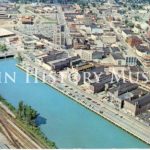Memorial Day is a day to remember the U.S. military personnel who have died in the line of duty and also a time to reflect on the soldiers and civilians whose lives were forever changed by U.S.-involved conflicts around the world. With a mind toward examining U.S. military history while wishing for world peace and a peaceful memorial day for veterans, military personnel, and people everywhere, the IDHH highlights collections from across Illinois that evince this history, remember veterans, and memorialize soldiers and civilians touched by war.
The state and its residents have a long history of involvement in most of the U.S.’s major conflicts, from the Civil War to present day. The IDHH’s numerous military history collections are particularly focused on the Civil War, World War I, and World War II, including the materials highlighted here. While there are dozens of institutions contributing invaluable content, the focus is on museums, following up last week’s post on International Museum Day: Veterans Memorial Hall and Museum and the Midway Village and Museum Center and the Bess Bower Dunn Museum of Lake County.
Veterans Memorial Hall and Museum’s collection includes photographic portraits of more than 70 Civil War veterans from the Rockford Area. The collection was previously curated and digitized by the Midway Village and Museum Center. The men in the photographs below represent just three of a small but nonetheless indispensable number of the more than 8,000 Illinoisans who served in the Civil War. Photographs were taken years to decades after the conflict, archived in 1968, and digitized only within the last few years, indicating a long remembrance of the Civil War and its impact on Illinois and its people.
The Bess Bower Dunn Museum features photographs, artifacts, and postcards pertaining to life at what was once a major U.S. Army post in the Fort Sheridan collection. The collection includes photographs of men and women posted at Fort Sheridan from the Spanish American War through the Vietnam War era. In addition to providing a record of everything from the most mundane to the most unusual aspects of life at Fort Sheridan, the collection is especially focused on the Women’s Army Corp (WAC) of Fort Sheridan from its beginnings during World War II until the integration of men and women units in the late 1970s
There are many other collections in the IDHH that commemorate veterans and evince the state’s military history, including the Pritzker Military Museum and Library’s Music of the First World War. There are also several collections provided by the Illinois State Library, including the Veterans History Project and the World War II Posters collections, and the Abraham Lincoln Presidential Library and Museum’s Boys in Blue collection of photographs Civil War soldiers. There are several collections documenting the service of residents of particular towns and regions in Illinois, such as the Coal City Public Library District’s World War II – From Homefront to Warfront collection, the Arlington Heights Memorial Library and Arlington Heights Historical Society’s Military History Collection, the Mel Tierney Post Servicemen File collection from the Park Ridge Public Library, digitized issues of the Melrose Park local newspaper, The Herald, from World War II provided by the Melrose Park Public Library, and Illinois State University Archive’s A University Goes to War, documenting women from the university’s involvement in World War I. For a complete list of collections provided by Illinois Digital Archive (IDA) contributing institutions, most of which are also in the DPLA, see IDA’s Military History page.














